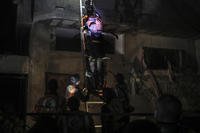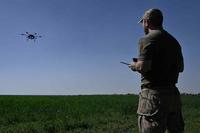The U.S. military’s much-discussed AirSea Battle will remain a priority in light of rising tensions with North Korea, ongoing military strategy assessments and continued budget constraints, Pentagon officials said.
In fact, Air-Sea Battle officials specifically said sequestration will in no way impede the development or continued importance of the Air-Sea Battle operating concept. However, its place within the new defense strategy is still being determined.
“Air-Sea Battle is a set of agreed-upon ideas and actions to create the joint force needed for operations in contested and denied environments and what that force needs to be able to do. Having smaller budget authority does not change the validity of [Air-Sea Battle’s] ideas and actions for force development, although it may slow [Air-Sea Battle’s] implementation,” according to a statement from the Air-Sea Battle office.
Air-Sea Battle currently being worked on by a conglomerate of Navy, Air Force and Pentagon strategists, was conceived of several years ago and articulated by both Pentagon strategists and think tank intellectuals.
“Air-Sea Battle's central idea is to develop networked, integrated forces capable of attacking and defending in depth,” according to a statement by the Air-Sea Battle office.
Air-Sea Battle is designed to counter what’s discussed as Anti-Access/Area-Denial strategies, a common buzz word in Pentagon circles as the military tries to transition from the wars in Iraq and Afghanistan to a potential conflict with a hybrid military such as Iran or North Korea.
The rapid development and proliferation of technologies has engendered a global environment wherein more sensors, jamming equipment, unmanned aircraft and precision-guided munitions are being developed and produced by more countries.
As a result, the U.S.’s longstanding monopoly on various kinds of technological superiority is slipping to countries like China, Frank Kendall, the top Pentagon weapons buyer, said in March.
Andrew Krepinevich, president of the Center For Strategic and Budgetary Assessment, explained that Air-Sea Battle is grounded in the goal of maintaining stability, deterring aggression and coercion.
“The basic idea is if you have a new and different kind of challenge in an area of vital interest - - the kind of equipment you will need will depend upon how you intend to fight,” said Krepinevich, who co-authored of the CSBA’s 2010 essay “Air-Sea Battle – A Point-of-Departure Operational Concept.”
This is not the first time services have tried to team up. The Army and Air Force developed a cooperative in the late 1970s and 1980s to defend the European Central front from a potential Soviet threat, Krepinevich explained. The idea was to have an integrated battle plan so that separate air and ground strategies were not developed in isolation, the essay explains.
Air Force and Navy leaders have tried to explain that Air-Sea Battle was not designed to defeat China. However, it’s hard not to recognize Air-Sea Battle’s importance when discussing a potential conflict in the Pacific Theater and the quickly increasing military capabilities of the Chinese military.
Potential adversaries to U.S. and its allies outside of China have made advances to long range ballistic missiles, to include various forms of precision guidance. Air-Sea Battle proponents point to the recent tests in North Korea as an example. Therefore, potential adversaries are able to make it much harder for U.S. ships to move into or operate in closer waterways.
Stealth long range bombers stands to serve as a key tenet of Air-Sea Battle. The Air Force continues to keep its next generation bomber alive despite the constant threat of budget cuts.
Intelligence, surveillance and reconnaissance (ISR) platforms will also play a key role within the Air-Sea Battle concept, Air Force officials have said. Ground commanders in Iraq and Afghanistan depended on the intelligence collected by the Reaper and Predator drones.
Air Force and Naval leaders anticipate that long range, speedier versions of these drones could serve a similar role over the Pacific to monitor ship movements.
The name of this new concept has left the Air Force and Navy’s sister services feeling left out. Army leaders have gone before Congress to emphasize their important in the forthcoming Pacific pivot to include a place within the Air-Sea Battle concept.
Some would disagree that Air-Sea Battle would not include the Army. A Navy captain and Air Force colonel wrote in the Armed Forces Journal that Air-Sea Battle is by no means intended to preclude the importance of ground forces but rather help set the conditions wherein they could successfully operate if called upon.
“Perhaps the most troubling misperception is that [Air-Sea Battle] is only about air and naval forces, that it ignores the land component. To the contrary: It is an operating concept that seeks to assure, in the face of rising technological challenges, that all components of U.S. and allied forces can be brought to bear as deemed necessary,” wrote Navy Capt. Philip Dupree and Air Force Col. Jordan Thomas.








